Are you looking for a way to set up a projector in your home or office but don’t want the expense and hassle of buying an expensive projector screen? You may have heard that using a white sheet is an option, so is it safe to use one as your projector screen? In this post we’ll explore the ins-and-outs of setting up a DIY projector screen using just a white sheet. We’ll look at how projectors work, what kind of white sheets are best for projection, and discuss some potential pitfalls you might encounter when trying out this approach. Read on to learn more about how you can leverage this clever low-cost solution.
What’s a Projector?
A projector is an imaging device used to project an image onto a large screen or wall. It can be used for a variety of tasks, such as displaying slideshows, videos, movies and games. Projectors are powered by either lamps or lasers and create the image by reflecting light off of the screen. Some projectors even have built-in speakers to allow for a better viewing experience. [1]
There are a variety of projectors available on the market today, ranging from basic models to high-end devices. When choosing a projector, it is important to consider factors such as image resolution, brightness level and contrast ratio. It is also essential to think about how and where the projector will be used in order to determine the right size for your needs. [2]
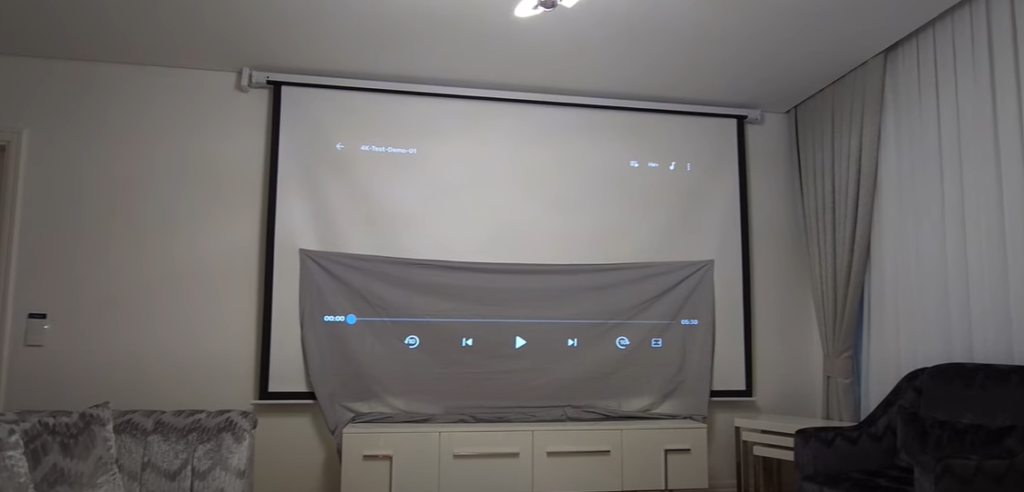
What are the Main Functions of a Projector?
Projectors provide an easy and cost effective way to share information and presentations with a large audience in a powerful way. Projectors can be used for both business meetings or corporate events as well as home theater systems.
The main functions of projectors include:
- Displaying images, videos and other media: Projectors are capable of displaying high-resolution images, videos and other media on large displays. This allows the audience to clearly view what is being presented or shared.
- Presentation sharing: Projectors can be used in business meetings or corporate events for presentation sharing. The presenter can easily share their information with a large number of people in a clear and effective way.
- Home Theater Systems: Projectors can also be used in home theater systems, providing users with an immersive experience for movies or gaming.
- Ambient Lighting: Some projectors are capable of displaying background light to create atmosphere when the projector is not being used for media output. This can be great for creating an atmosphere at parties or events.
- Projection Mapping: Projection mapping is a technique that uses projectors to turn objects into interactive displays. This can be used for special events, such as art installations or live performances. [3]
How to Make the Projector Display Clearer?
If you want to get the most out of your projector, it’s important to make sure that the display is as clear as possible. Here are some tips on how you can ensure a clearer and sharper picture:
- Make sure your projector is in focus. Depending on the type of projector, you may need to adjust either the lens or the focus knob in order to get the desired result.
- Adjust your screen resolution and aspect ratio for optimum clarity. Each projector has its own recommended resolution settings, so make sure you have these set correctly. Additionally, try altering the aspect ratio to find a setting that looks best on the projection surface.
- Increase brightness when necessary. Too much light may wash out the image, but too little light can make it difficult to see. Use the projector’s brightness settings to find a good balance where you can still clearly see all of the colors and details in your projection.
- Verify your connection type for maximum clarity. Different types of connections have different data rates, so be sure you are using an HDMI connection if you need the highest quality picture.
- Turn off any ambient light sources. If there is a bright light source in the room, it can interfere with your projected image and make it look fuzzy or distorted. Try to keep the lights turned off while using the projector for best results.
- Clean your lens regularly. A dirty lens can cause discoloration in your projection, so make sure to keep the lens clean and free from dust or debris.
- Make sure you are using a compatible source device. If you’re connecting your projector to a laptop or other type of device, be sure that it is compatible with your projector model. This will ensure that you get the best display quality possible.
- Check the projection surface for optimum clarity. The projector should be placed on a flat, non-reflective surface in order to get the clearest picture. If necessary, use a matte white wall or screen material to make sure that you get the best image possible. [4]
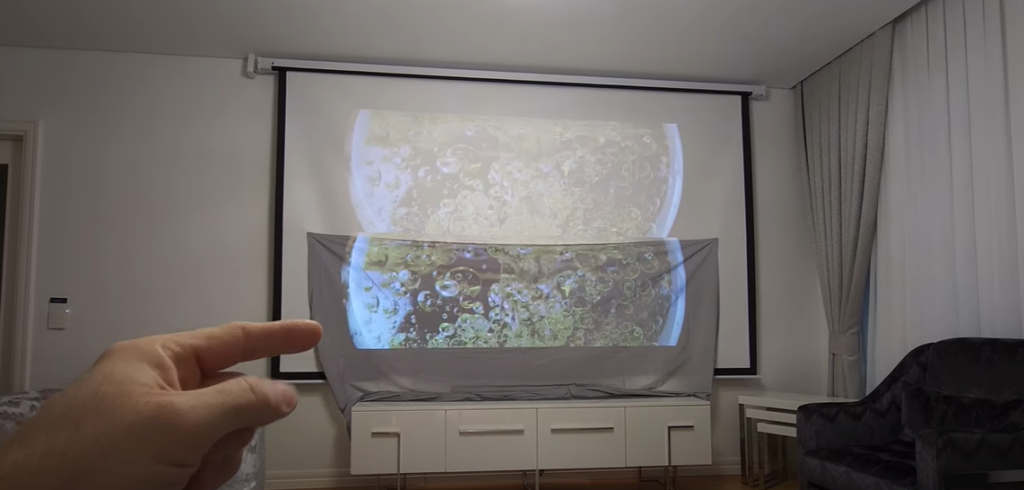
How to Adjust the Projector for Better Display?
Projectors are becoming increasingly popular for a variety of uses, from displaying movies in the home to presenting slideshows and other presentations in the office. To get the best display possible from your projector, you need to make sure it is properly adjusted. Here are some tips for making sure your projector is set up correctly:
- Make sure the projector is placed at the correct distance from the screen. Depending on the type of projector you have, the ideal distance is usually between 1.4 to 4 meters (4.5 to 13 feet).
- Make sure your projector is level with the floor and that it’s pointing straight at the screen. You can use a spirit level on top of the projector to check this.
- Adjust the contrast and brightness settings on your projector to get the best image quality possible. This will vary depending on the type of projector you are using, so be sure to check your instruction manual for specific instructions.
- If you’re projecting onto a wall, make sure it is painted a light color. Dark colors can absorb too much of the light from the projector and make it difficult to get a good image.
- If you’re using a screen, make sure it is of an appropriate size for your projector. Some screens are simply too large or too small and can impact the quality of the image you see.
- Always check that all of your cables are connected properly and that they’re securely fastened to the projector and screen. Loose cables can cause interference or even damage your equipment.
- Ensure that any accessories such as speakers are connected correctly and turned on before you start using your projector. [5]
How to Make a Projector Screen with a White Sheet?
Making your own projector screen can be a great way to enjoy movies or presentations in the comfort of your home. It’s also an easy and affordable DIY project that doesn’t require expensive materials or equipment. Here’s how to get started:
- Choose the right fabric. You’ll need a white sheet or other light-colored material that is opaque but also allows light to pass through it. Avoid thin fabrics like silk or cotton as they won’t provide enough contrast. Look for a thicker fabric such as canvas, muslin, or even unbleached linen.
- Hang your screen from a wall or ceiling. Make sure it is taut and secure so that the fabric won’t sag or wrinkle when you project onto it. You may need to use picture hooks, curtain rods, or other supports to hold up the screen.
- Adjust your projector settings as needed. Depending on your environment, you may need to increase the brightness of your projector or turn down the contrast to prevent any glare. Also adjust the zoom factor if necessary so that your image fills up the entire screen.
- Test it out! Once you’ve set everything up, it’s time to test your projector screen and make sure it works as expected. Try playing a movie or showing a presentation on the screen and see how it looks. Adjust any settings as needed until you’re satisfied.
That’s it! With a few simple steps, you can have a homemade projector screen that looks just like the ones in professional theaters. Enjoy your movies or presentations and have fun! [6]
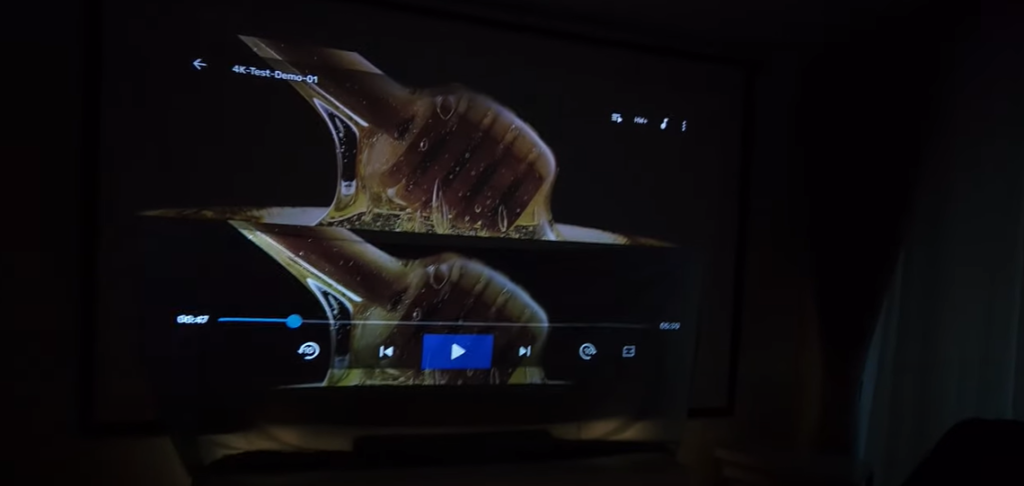
Problems with Using White Sheet as a Projector Screen
When it comes to projecting a presentation, one of the most popular solutions is to use a white sheet as a projector screen. While this may appear to be an effective and cost-efficient solution in many cases, there are some drawbacks that must be considered when using a white sheet as a makeshift projection setting. They include:
Poor Quality Image
Projecting an image onto a white sheet can lead to the image being distorted and generally of poor quality. This is due to the fact that the fabric of the sheet absorbs some light from the projector, making it harder for a clear picture to be painted.
Poor Color Representation
Using a white sheet as a projector screen has also been known to give poor color representation. This is because a white sheet reflects all colors equally, and the focusing ability of most projectors cannot accurately reproduce certain hues and shades on such a surface.
Inadequate Lighting Conditions
One issue with using a white sheet as a projector screen is that it usually does not provide an adequate lighting setting for projecting images. If the room is too bright, for example, then it may be difficult to make out the image. Likewise, if the room is too dark, then the image may appear washed-out.
Inability to Change Image Size
Lastly, using a white sheet as a projector screen does not offer much flexibility when it comes to changing the size of projected images. This means that any changes made to the size of the image must be done directly on the projector, rather than from a distance.
For these reasons, it is important to consider other options for projection settings and scenarios before relying exclusively on a white sheet as your primary option. While it may appear to be an effective solution in many cases, there are numerous drawbacks that must be taken into account when deciding whether or not to use a white sheet for projection purposes. [7]
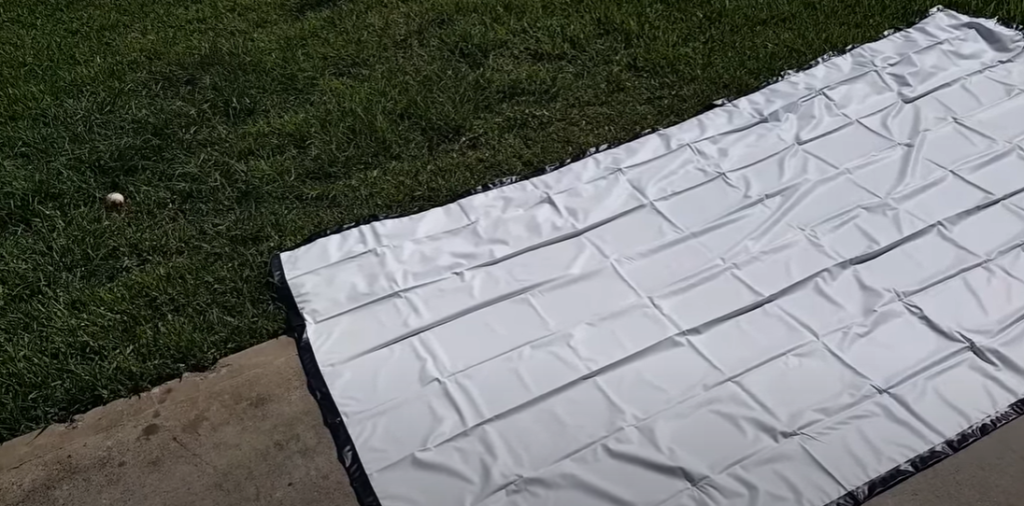
Best Alternatives to White Sheet for Projector Screen
Projectors are very popular tools for presentations and movie watching in the home. They can display images on a variety of surfaces, such as walls or windows, but one of the most common uses is with a white sheet hung up as a projector screen. While this is an effective way to display images, there are other alternatives that may provide better image quality. Here is a list of the best alternatives to white sheet for projector screens.
- Projection Fabric: There are many different types of projection fabric available on the market today, ranging from specialized materials to more common options like cotton and muslin. These fabrics provide excellent image quality and don’t produce as much glare compared to white sheets.
- Portable Projection Screens: Portable projection screens are an excellent choice for those who need to move the projector around frequently. They come in a variety of sizes and shapes, such as triangle or square, and can be used both indoors and outdoors.
- Projector Paint: If you’re looking for a permanent solution for your home theater or presentation room, consider using projector paint. It’s a specialized paint that is designed to give you the best image quality and is easy to apply. You can also get creative and customize it with your own design or logo.
- Rear Projection Film: This film is made of special materials that are designed to create a uniform projection surface without any glare from light sources. It’s perfect for home theaters, conference rooms, and other places where you need a large projection area.
- Projection Screens with Stand: These screens are available in many different sizes and shapes, such as square or triangle, and come with a stand for easy setup. They provide good image quality and can easily be moved around when needed. [8]
FAQs
What material can I use for the projector screen?
There are several materials that can be used for a projector screen, such as white sheets, fabric screens, and special projection screens. The best material to use for your projector screen will depend on the size of the space you’re working with and the type of setup you have. White sheets are a great option for smaller spaces or if you’re looking for an inexpensive solution. They are also relatively easy to set up and will provide a clear, sharp image for your presentation. However, if you are looking to optimize the quality of the projected image, then you may want to consider fabric screens or special projection screens as an alternative. These materials offer better brightness and color accuracy compared to white sheets, making them ideal for more professional applications.
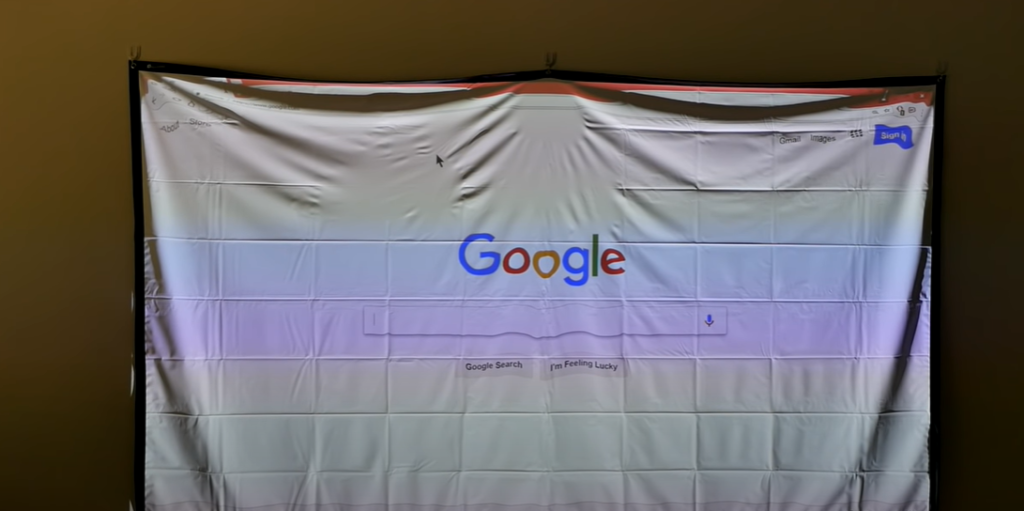
Should I use a black or white sheet for a projector?
While both colors offer a similarly clear image, if you’re looking for the best possible picture quality, it’s generally recommended to opt for a black screen as they tend to provide better contrast and brightness levels. They’re also less likely to be affected by ambient light, meaning you won’t get washed out images when using a projector in bright rooms.
White screens, on the other hand, provide improved clarity and sharpness which makes them ideal for displaying detailed graphics or text-heavy slideshows. Additionally, white screens are often the best choice for environments with low-light levels since they tend to reflect more of the projector’s light back towards the audience.
Do projector screens matter?
Projector screens can have a huge impact on the quality of your projected image, making them important to consider when setting up an AV system. White projector screens are popular choices because they offer a bright and sharp picture with wide viewing angles, but there are some drawbacks that should be taken into consideration.
White projection screens often require more light output than other materials, which means that the projector needs to be bright enough to ensure the image is visible. This also limits the types of lighting you can use in a space, as certain colors may cause glare or wash out details of the projected image. Another factor to consider when selecting a white projector screen is its gain. This refers to how much brighter an image appears on the screen compared to other materials and can be adjusted by varying the reflectivity of the surface. Higher gain screens will produce brighter images but may also introduce some hotspots or uneven brightness.
For larger spaces, you may want to consider using multiple projection screens in order to create a wide and uniform image. With this setup, it’s important to ensure the projector is bright enough for the size of the space and that all screens are properly aligned for optimal viewing angles.
Is white or gray better for a projector screen?
When you’re setting up a projector screen, the question of whether to use white or gray surfaces comes into play. Both are viable options, with their own benefits and drawbacks.
White screens generally offer more contrast, making them better for dark rooms with minimal lighting. By using a white screen, images will appear brighter and sharper than they would when projected onto a gray screen. Additionally, white screens provide better visibility in well-lit rooms, since the darker projection won’t be washed out by ambient light.
Gray screens, on the other hand, are better for rooms with lots of windows and natural sunlight. Gray surfaces can help reduce the glare from direct sunlight or bright artificial lights that could otherwise wash out the projected image. Because the gray surface absorbs more light, it can also help to improve the overall contrast of the image and make colors appear more vibrant.
Useful Video: Grey Projector Screens vs White ( Cheapest Ambient Light Rejection )
Conclusion
Although using a white sheet as a projector screen may be an option if you are in a pinch, it’s important to remember that there are also alternative solutions available. Purchasing an actual projector screen or setting up a front projection system can be the best way to ensure that your images and videos look their absolute best when presented. That being said, so long as you make sure that your white sheet is large enough, is outdoor-appropriate, and is hung evenly, it could be a good short-term solution for more casual presentations or even special events. For those who have ever asked themselves “Can I use a white sheet for my projector?”, now you have the answer: maybe – as long as you keep these factors in mind!
References:
- https://www.computerhope.com/jargon/p/projecto.htm
- https://www.javatpoint.com/what-is-a-projector
- https://www.essaysusa.com/article/the-uses-and-functions-of-the-projector
- https://www.techwalla.com/how-to-make-a-projector-more-clear.html
- https://thehometheaterdiy.com/adjust-projector-image/
- https://pointerclicker.com/how-to-make-a-projector-screen-with-a-sheet/
- https://visualjacker.com/white-sheet-projector-screen/
- https://thehometheaterdiy.com/best-material-to-use-for-a-projector-screen/

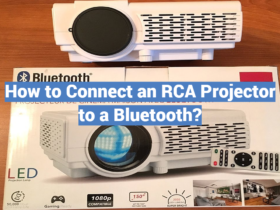
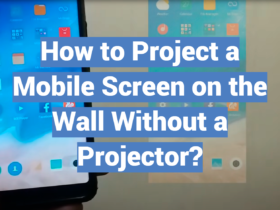

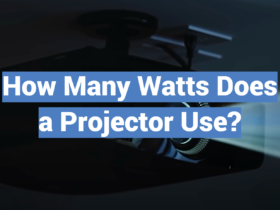
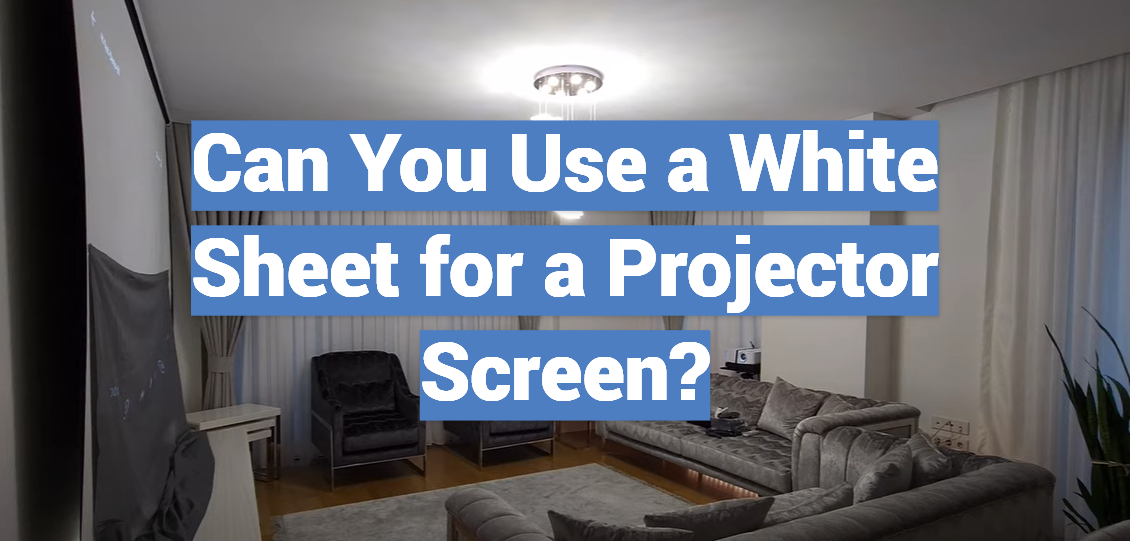

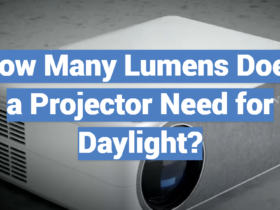

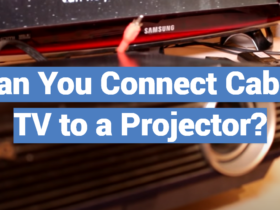
Leave a Review